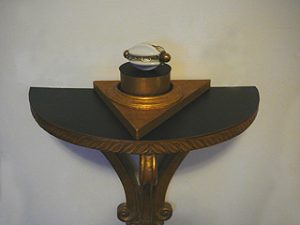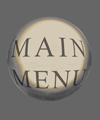2023, Week 3
The year begins on a note that sets the tone for future developments. Finally a golden swimmer made the year before is mounted on a rock face in the garden. The figure is the gnomon of a sundial with the foreward reaching hand being the pointer. Due to the irregularities of the rock, exact calibrations for the hours must be carried out by hand and for the equinoxes and winter solstice, this has already been done. There thus remains only the calibration for the summer solstice.
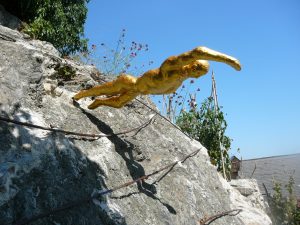
2023, Weeks 4-6
Reading the work of Ulrike Herrmann I decide to increase the number of Reloading Humanism Fellows to twelve. This would enable the ecconomic theme introduced via the person of Liza Herzog, to be expanded upon and would further enable the themes of political structures and sustainability to be introduced. To this effect I read the two books written for a wider public by Maja Göpel and begin writing the texts that introduce her and Ulrike Herrmann.
2023, Weeks 7-8
Taking a break from writing, I begin work on a medium size standing male figure. Around a metre high, the departure point is the Ancient Greek kouros of the Archaic Period.
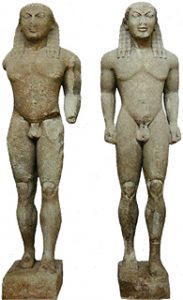
The work is for the garden and is to be taken inside each winter. I therefore decide to make it as light as possible and use the same technique used for the golden swimmer. Where the golden swimmer has a single rod as a back-bone, for the kouros I use the arm and support of a broken, adjustible desk-top lamp as a skeleton. As the leg and arm of the lamp consists of two rods running parallel to each other (and along which a 12 Volt flow of electricity once flowed) this means that each leg has its own seperate rod. The advantage of the lamp is that the kouros can be made to slot into the heavy base. With the approach of winter the two parts, heavy base and light figure, can be seperated and carried down into the shelter of the attic. After making the skelton, wrap chicken-wire around it and slowly begin marking out the forms to be. This done, the next step is to spray window-mounting foam into the spaces deliniated by the chicken wire. As the foam is designed to expand massively, worms of foam expand out through the wire. Once hardened, the excess is easily removed with a knife and the rudimentry forms hinted at by the chicken-wire can be given a lot more definition. Nevertheless, there is still a long way to go. Using Uhu, the next step is to glue Fimo Light, a light kind of children’s modelling clay, to the foam forms.
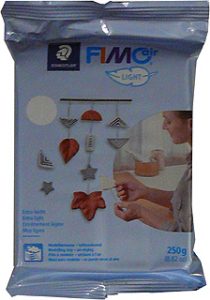
This results in an impressionistic form of kouros. Painted with a bronze finish that can be made to oxidise, I could then leave the work at that. Yet this would be appealing to a romantised, garden aesthetic. Although this is a tempting prospect, I decide that this is not what the project is about and that to remain true to the ethos of what I originally intended, I must carry on do a lot more work. Here however I am interrrupted and a much longer break than intended sets in.
2023, Week 9
In Scotland I show photos of the kouros to be to my friend, the sculptor Chris Hall, who not only lives in the Scottish Borders but has recently become a near neighbour of my father’s (as opposed to being a far neighbour which he was before). See: https://www.chrishallsculpture.co.uk.
Needless to say, Chris immediately sees were my kouros is coming from and we talk of Jane Harrison’s seminal and wonderfully inspiring Themis A Study of the Social Origins of Greek Religion (1912). Along with the works of Karl Kerényi on Demeter and Kore, this is a must read for anyone who wants to understand Greek religion. During this time, whenever I think of the project, what Harrison calls The Song of the Kourates springs to mind:
To us also leap for full jars, and leap for fleecy flocks, and leap for fields of fruit and for hives to bring increase, Leap for our cities, and leap for our sea-borne ships, and for our young citizens, and for goodly Themis.
2023, Weeks 10-12
Returning to the Reloading Humanism People Page, I write the article that introduces Ulrike Guerot. Working on the images for the new pages I also review and co-ordinate all that has been written so far and in a number of texts refer to films and children’s books in an effort to give abstract ideas substance and credibility. The films include, Ishtar, The Big Short and Into the Wild, the children’s books, Alice’s Adventures in Wonderland and Paddle to the Sea.

2023, Week 13
Back in Austria, at the Annual General Meeting of the artists‘ group, Raumgreifend, of which I am not only a member but also treasurer, I agree to submit a work for a group exhibition in the Czech Republic in a place called Volary. The plan was submit something old that has not been seen outside the UK but the more I think about it, the more unhappy I get with the idea and decide instead to make something new. This is to be a blackboard on which there are two figures accompanied by words in Humanese which outline concepts which the figures embody and illustrate. In addition there is to be a summarisation of how the regular plane figures, as they acquire more and more sides and approach a circle, describe not a straight line but a curve known as a tractrix. This process was seen by the mathematician and theologian, Nikolaus of Kues, otherwise known as Cusanus, as a way of approaching the all-encompassing transcendence of God. See the Laboratorium geometricum mellicensis on the Reloading Humanism Mission Page for more.
2023, Week 14
The April edition of Austria Maritim arrives with the second of three articles I have written on a trading schooner captained and partly owned by my great, great, grandfather. Made on a beach in Cornwall, the W. J. C. was named after the Christian names of the original owners and was launched in 1880, with my ancestor being the first captain and remaining master of the vessel up until 1897.
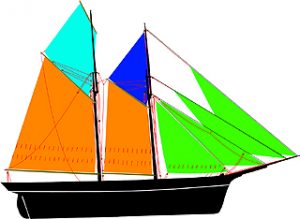
Instead of being built from plans on paper, most schooners were built from half-models. Of these working half-models, very few have survived but these few include the one from which the W. J. C was built.

Equally unusual, the vessel was laid up in the same estuary where she was built and over the years, both as children and as adults, my brother and I have repeatedly visited the site where in the mud, the last remain lie and fished out remains
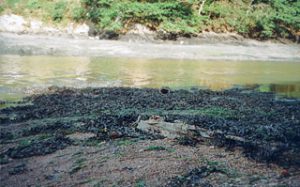
For the first and second parts of the article, see: https://www.fhsaustria.info, https://www.fhsaustria.info. For the link to the last part, jump ahead to Week 26. For those who do not read German, one of the many plans for 2024 is to try and get the articles published in English in an appropriate British magazine.
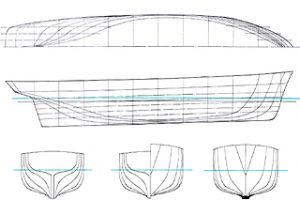
Apart from the fun of reconstructing something from the past and the fascination of the remains of a ship buried in the mud, for me as a sculptor, the ship, its half-model and the lines that can be extracted therefrom, are a form of manifest. For although I see sculpture in terms of forms that can be seen by the eye as highlights and shadows and haptically felt through touching and handeling, I also see sculpture mathematically – with a work being the sum of an infinite series of profiles. This makes a sculpture an infinite assembly of curves in space, that theoretically could be summarised by an infinite list of equations. This puts into context the brushes I had with my sculpture tutors in Edinburgh in the Eighties, who thought that sculptors should do sculptural drawings with lots highlights and shadows – indicative of depth and form. I however worked with lines and did drawings that were „as flat as pancakes“.
2023, Week 15
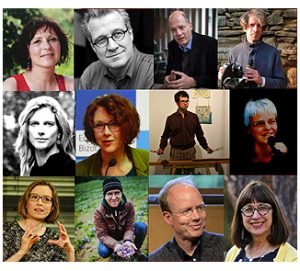
After five and a half years, the Reloading Humanism website has come of age! Now uploaded, on the People Page, there are twelve „Fellows“, six men and six women listed in alphabetcal order. Meanwhile the prism on the Main Menu Page has been re-vamped and instead of being a prism formed from an equilateral triangle, it is now a three-dimensional rendition of a diagram given by Piero della Francesca on the end of his Libellus de quinque coribus regularibus or, „Booklet on the Five Regular Bodies“. The significance of this is the subject of an artice on Piero della Francesca written by myself and which will hopefully be published during the course of 2024. Although details cannot be gone into before publication, the triangle is a 13,14,15 triangle with the internal perpendicular on the side of length 14 being of exactly 12 units in length, while the diameter of the circle that the triangle contains, is 8 units. As shown in the article, the triangle has other properties which Piero was more than aware of, so that by placing the triangle at the end of his book, he is in fact hinting at something that in the exercise is not even mentioned but which was important to him and the geometry on which some of his paintings are based. At Reloading Humanism, while the perpendicular of length 12 fixes the number of Fellows at twelve, the triangle as a whole is seen as a metaphor for that something other towards which we must all work towards if we in the western world are to have a future.
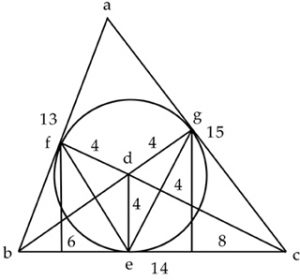
2023, Week 16
For the alumini magazine of the boarding school where I spent five and half years, I write an article and supply an illustration – knowing full-well that it is a moot point as to whether it will be accepted. As my scepticism turns out to be well-founded, for the story and explaination of the drawing, click on the toggle title below.
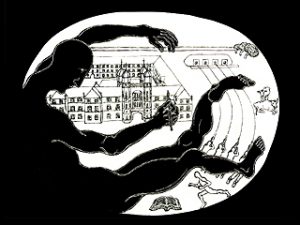
Article: Of Shanty Town and black and white marbles in a Jar
Although at school I did „A-levels” in maths, physics and chemistry and it was in the library where discovered art and resolved to become an artist, it was in “Shanty Town” where I first encountered philosophy. This was a sizable room in my house, where some of the Lower Sixth had bedsits with temporary walls formed from desks and curtains. Due to a lack of studies, I became a resident of Shanty Town a year early. A room-mate decided that this injustice could only be amended through the regular bending of my limbs in directions unforeseen by nature. Though I bore these late night rituals with Stoic humour, I never mastered the art of doing so in silence and the next day, fellow Fifth Formers would ask, if when being tortured, I could please refrain from making so much noise as despite the brick wall between us, they could hear my cries in their dormitory. Shanty Town was where the house library had once been and in front of the window that looked out onto the square, there were stacks and stacks of books. In a dog-eared volume with yellow pages, I found a drawing which opened up a host of daring and exciting new questions: “Is the world real?” and if it is, what is the status of the dimensionless and yet omnipresent self through which it is experienced? Subjecting the work to proper examination, I was disappointed to find that the drawing was but an introductory motif to a dubious interpretation of quantum mechanics. Thus for the rest of the year, the philosopher in me was confined to the Stoic enduring of pain.
The next year I had a bedsit of my own whilst philosophical prompting came when poor Mr. Carpenter tried to teach me probability. Here I reacted allergically to the idea of the complexity of the world being reduced to a sterile model of black and white marbles in a jar. Thirty years later I can retaliate with chaos theory which, only just coming into being at that time, is a branch of mathematics that is capable of explaining both the world of black and white marbles and the much more interesting world of “dynamic systems”. The relevance of this to us today is that it is chaos theory that lies behind the myriads of fragile eco-systems on which our lives depend. For far too long we have been seeing the world in simplistic, black and white terms, blithely assuming that it will always behave in a linear fashion regardless of what we do to it. Meanwhile, not forgetting the questions posed by that drawing discovered amid a pile of books, adapting a system of projective geometry from the Antique, I have developed a mathematical model of the self that, unlike other models, comes complete with an axis of value and yes, hidden in the mathematics there are the constants of chaos theory. This makes us moral beings through and through and yet, we must always remember that feelings of right and wrong are one thing, whilst analyses of right and wrong are another. Where feelings are rightly felt as unequivocal, analyses are based on information that is collected on the basis of assumptions that may involve inappropriately simplistic models, such as black and white marbles in a jar. Thus at Reloading Humanism, the website I run, a selection of different people and different ways of looking at the world are presented along with the historical analyses on which their views are based. Not only have we been looking at the world in simplistic, black and white terms for far too long, we have also become callous and indifferent to history and the long and fascinatingly complex story of who we are. See www.reloading-humanism.eu for more!
2023, Weeks 17-19
Jumping between working on the website and working flatout on the Volary piece, time flies and I am close to being caught out.
2023, Week 20
Finishing the work for Volary is a close run thing but the effort pays off and both formally and in terms of content, the work is step forward and dissolves the jealously guarded borders (drawn up by self-appointed experts) between art and philosophy. With the human figures being much more expressive and communicative than I thought they would be, the need for words written in Humanese becomes unnecessary and so the figures stand and hang, saying everything that needs to be said for themselves whilst the void around them also speaks for itself. See the middle section of the article One World Pragmatism on the Reloading Humanism Mission Page for detailed images of the work.
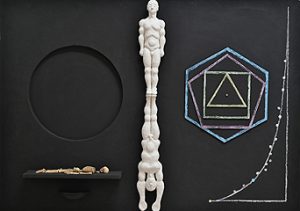
2023, Week 21
On holiday in Altaussee I visit the salt mine where during the war, thousands of works of art were stored, including Saint Vitus in a Vat and a number of other sculptures from Museum Krems. During the last days of the war, the mine and its contents were earmarked for destruction as an over-zealous interpretation of Hilter’s infamous Nero Decree and eight, one thousand Pound bombs were planted deep inside the labyrinthine network of tunnels. Reading a copy of Konrad Kramer’s Mission Michangelo bought from the excellent bookshop in Altaussee, „Buch & Boot“, I learn how, for two weeks, it was touch and go as to whether madness or common-sense would prevail and that during this time a number of important works were removed from the mine and stored not only in the local church but also in the vicarage where I myself am staying! See The Triangle and the Saint from Krems on the Reloading Humanism Mission Page for more.

2023, Week 22
In Volary, the Raumgreifend exhibition is opened with a number of members attending.
Invited to take part in the „Schallwelle – Festival New Music Festival“ or „Soundwaves Festival for New Music“ in Feldkirch, Reloading Humanist composer, Martin Gut, has been using the words of a poem of mine, Floundering, as lyrics. This is a four-line love poem on the intoxication of a first meeting:
Tottering on my sea legs I trapsey up the beach
and deigning to approach ask of you foolish questions
as transfixed in the gaze of eyes that intoxicate
you judge me not as I flounder in this world so new.
Although pleased with the way the composition has turned out Martin feels that a coda is needed and has requested something written in the still-in-the-process-of-being-invented language, Humanese. Thus over the course of a few days, I write a euphorically optimistic coda:
eresasine phephlumenete
ittklimaste sassam
thurmorkip ektistessen
ere-anyas sin‘ ayarken
que-e-ayta voita sinassas
net quaysa ettinen ay?
This translates as:
Confused feelings
of love now
dissolve an intraversible boundary
their being (carrying) me upwards.
What deeds are we
not capable of?
2023, Week 23
For Foundering Martin has requested, in addition to the coda, an additional word but I supply two, the first of which is, „soi-e-a-u“ or „soi-e-a-o-u“. This doesn’t have a definite meaning but is life affirming and positive. Another positive exclamation is: „ay-a-o!“ By way of contrast there is: „io-ee-a zazi-apsen re-a-sis“ which means „climbing transformatively out of tar“.
For the micro-tonal music festival, „Am Sound“, held every year in Krems in September, of which Martin is the initiator and organiser, I have been invited to mount an exhibition in one of the festival venues. This is the café El Très, Krems‘ „Spanish sitting-room“. I conceive the exhibition as consisting of reliefs, featuring words and concepts in Humanese accompanied by hieroglyphs and diagrams. Goaded into action by last’s week’s work on the coda, I decide to continue with Humanese and embark on some preparations and detailed planning. The relief’s are made from planks of wood which for a number of years have served as walk-ways through the beds of the vegetable garden.
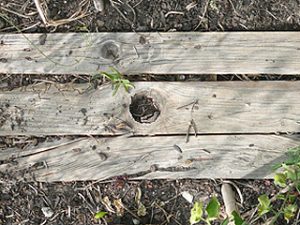
Not only ripe of age, they are also highly distressed and thus for me, intriguing. Sanding them down, I cut them into shape and treat them for wood-worm. Then upstairs, in my Humanese-English, English-Humanese dictionary, I draw, work out concepts and invent new words.
2023, Week 24
Prompted by my visit to Altaussee, I begin the task of reconstructing the wartime history of the Museum Krems sculpture, Saint Vitus in a Vat. This is because some two years ago I made an exciting discovery about the composition of the work and since then have been intermittently working on an article and although this has nothing to do with the sculpture’s wartime history, I feel duty-bound to be informed on the sculpture’s later history. At the end of the Hollywood film, Monuments Men, the Altaussee story is given a very sketchy treatment film but is covered in a more informed manner by the Austrian/German production Ein Dorf wehrt sich. Meanwhile the wider context is mapped out by Lynn Nicholas in her book, The Rape of Europa: The Fate of Europe’s Treasures in the Third Reich and the Second World War. While there is plenty of material on the subject, information on the Krems sculptures is lacking and it is only slowly that I am able to piece together the complicated puzzle that begins exactly eighty years ago.
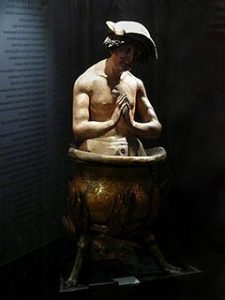
2023, Week 25
Over the course of a few days, on the sundial set up in January, the calibration of the hours on the day of the summer solstice is finally completed.
On the internet I find an article detailing the wartime history of a collection of manuscripts that were dispossessed by the Municipaltiy of Krems from the Benedictine Monastery of Göttweig on the other side of the valley. As these manuscripts were also sent to Altaussee and spent time in the mine, the references given give me all the clues I need about where the documents detailing Saint Vitus‘ wartime odyssee are to be found.
2023, Week 26
The July edition of Austria Maritim arrives with the last article by myself on my great, great grandfather’s ship. See: https://www.fhsaustria.info.
2023, Week 27
This week is ear-marked for the photographing of a heliacal rising of the Pleiades, the constellation of stars known through out Europe as „The Seven Sisters“. The heliacal rising of a star is when a star rises above the horizon shortly before the sun and for a short time is visible before being outshined by the rising sun. During the Bronze Age the heliacal rising of the Pleiades took place much earlier in the year and was a sign for when the corn was to be planted out. Unfortunately, every morning the shy is overcast, with the sun only breaking through some hours after sunrise.
In Vienna I have an exciting time sifting through WW II documents concerning the storage of art and artefacts at Altausse and gain valuable insights concerning the war years of Saint Vitus in a Vat and the other sculptures from Museum Krems. Finding the Bundes Denkmalamt’s Department for Provenance Research was however less than straight forward: as intimated, the office is in the Hofburg above the Sissi Museum/State Apartments but the entrance (an iron gate in the attic) is unmarked and unlit. After climbing up, down and back up the stairs leading to the fifth floor, I bump into someone in the corridor and confirming that I was looking for the Provenance Department, am told to press an unmarked button. This turns out to be an entry phone. Although no one answers, from the shadows a figure appears and I am lead through the darkness into…, a perfectly normal office!
2023, Week 28
In order to secure funding for a guide book to Krems and the Wachau and thereafter to enjoy the advantages of a tax-free status on all sales, I have decided to found a charity. For this a set of statutes must be drawn up which is then submitted to the authorities for approval. The drawing up of statutes however raises a host of questions concerning the plans for book publishing, film nights and a sustainability library and café, with all this needing to be thought through so an appropriate legal framework can be drawn up. Yet this in turn raises questions about how the social aspects of these activities are to be managed and how they are to be related to the rhythms of year and the realities of life in general. Here customs, rites and rituals suggest themselves which if they are to withstand the eye of critical scrutiny, must be carefully crafted and tailored so as not to appear too arcane whilst at the same time, they must also be more than just flippant gags and gimmicks, for otherwise, I for one, am not interested. Thus in order to embed the venture of founding a charity in something that is believable and which can be believed in, a considerable of preparatory work with symbols and artefacts is necessary and I find that, to pull everything together, a coat of arms is needed.
2023, Week 29
Drawing up a coat of arms, I find that to endow their bequeathing with the desired degree of authority and seriousness, two poems must written.

To see the arms complete with helm, crest and supporters and read the poems, go to De re juridica, on the Reloading Humanism Mission Page. The crest is a hoopoe bird, not only a bird replete with cultural connotations, it is also a bird that I have seen at close quarters, when one evening a juvenile landed on a post in the garden and I was sitting in the summer house. As it landed it folded its crest down and then looked about and espied myself. After looking at each other in silence for what must have been a full minute the bird decided that hanging out with humans was maybe not the done thing to do and flew off again. In Aristophones‘ The Birds, the hoopoe bird, called by the Greeks „upupa epops“ is king of the birds. In The Qur’an, knowing that there is a country in Africa that is ruled by a queen who worships the sun, the hoopoe bird knows something that Solomon does not and so serves as a messenger between Solomon and Sheba (27:22-23). Departing from this, in the Sufi poem, The Congress of the Birds by Farid ud-Din Attar, it is the hoopoe bird who suggests to the assembled conclave that they search for the Simurgh and who admonishes the faint of heart. In its claw, the Reloading Humanism hoopoe bird holds an apricot, whose tree is self-fertilising and so embodies the motto, „Out of its Self“ that is the motto of the coat of arms.
A second visit to the BDA, or „State Monuments Office“, answers most of the remaining questions concerning Saint Vitus‘ war years, with the last remaining queries being answered a few days later by a mail from the Austria Salt Works Incorporated, or Austria Salienen AG. The full story of Saint Vitus‘ sojourn in Altausseerland and of how thousands of works of art nearly got blown up, can now be read in the article, The Triangle and the Saint from Krems, on the Reloading Humanism Mission Page.
2023, Week 30
After the lull and collapse of the corona years, river cruise shipping on the Danube is at an all-time high. Sent ashore, disorientated passengers wander aimlessly about Krems and Stein, while other groups are goaded through the towns by guides and subjected to barrages of dates and data. To counter this I decide to offer something more bespoke and informative and on the Reloading Humanism Mission Page augment the News and Wachau Tips with a Wachau Town Tours page. Here Audio guide tours of the four towns, Krems, Stein, Dürnstein and Melk, where the cruise ships stop, will offer carefully crafted, informative tours that can be listened to on a smart phone. My web-programmer coming up with the appropriate App, I immediately start work on a tour of Krems whilst on a day off, I scout out the next door town of Dürnstein and identify both the tour route and the areas where I am lacking in knowledge.
2023, Week 31
After the guide to Krems, this week is dedicated to the audio guide tour of Stein. Where apart from history, the tour of Krems features religion, belief and heresy, the tour of Stein has, as a secondary focus, the river, ships and shipping and fish. Though I myself am no fisherman, I know someone who is and quickly get the low-down on fish in the Danube.
In Lower Austria there are today sixty-four different kinds of freshwater fish. Twenty-nine of these are either endangered, strongly endangered or are by ways of becoming extinct. Another nine are at a critical level and the eel is already regionally extinct. Ten kinds of fish are not indigenous but were introduced to Lower Austria by human beings after 1492. Of these, the latest arrival is the Black Sea goby which by clinging to the bottoms of ships with a sucker mounted on its underside, over the last twenty years has settled in the Austrian reaches of the Danube, unobtrusively joining the other species of goby on the riverbed.
2023, Week 32
Weeks after beginning to address the business of founding a registered charity, I finally find myself writing the Reloading Humanism statutes. For this I have a book and a template from a lawyer on the internet.
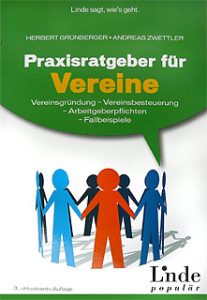
Essential for a charity is an ideal and a mode of operation that is not geared towards profit but simply the paying of the bills that propagating and following the ideals embraced entails. Going hand in hand with this, it is important that there be a communial aspect that benefits the members of the society. From this, with respect to the Reloading Humanism initiative, there arises a differentiation between Committee Members, Working Members, Guest Members and Honary Members. Due to the copyright issues of publishing and the designing and selling of products there is however a certain amount of nitty gritty that needs to be carefully thought through.
2023, Week 33
After draughting the Reloading Humanism statutes, I realise that, as we live in a world dominated by consumerism, if the initiative’s friends, readers and supporters are to be given the chance of fully interacting with what is being offered, then there must be a shop from which appropriate products can be ordered so that they can be a part of what is going on in a way that goes beyond on-line reading.

To this effect I spend the week drawing up a list of appropriate products and books, with old products (paper models) being dusted down and re-packaged whilst new products (such as a mug and a coin) are designed from scratch.

2023, Week 34
For the forthcoming series of Reloading Humanism Guides, I decide upon the first two titles. These are an introduction to the Ancient Greek philosopher, Parmenides and an account of the self and consciousness worked out by myself, with the latter being briefly summarised in the article, One World Pragmatism, on the Reloading Humanism Mission Page.
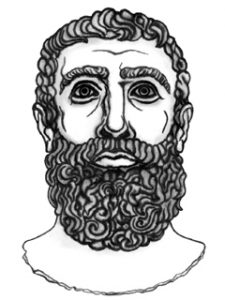
At a meeting in El Très, the practicalities of the forthcoming exhibition, The Eresine Tablets are discussed and the opening is fixed for Saturday, 30th September, 19.00. As the philosophy of Parmenides is relevant to the exhibition, there will also be a finissage at which the above mentioned Reloading Humanism Guide will be presented. At this event I will read the beginning of Parmenides‘ poem in the original Greek before reading a lively and radically new translation of the surviving fragments in English.
2023, Week 35
At long last, my article on Saint Vitus and the mysteriously out of place last exercise of Piero della Francesca’s Booklet on the Five Regular Bodies is submitted to the Krems Town Archive for publication in their Proceedings of the Krems Town Archive. As briefly announced in the essay, The Triangle and the Saint from Krems, accessible via the Reloading Humansm Mission Page, the article argues that both in plan and elevation, the composition of a sculpture of Saint Vitus held by Museum Krems is based on the 13,14,15 triangle with which Piero concludes his Booklet. Using a new methodology to make its case, the article then goes on to examine the reasons as to why it was decided to base the composition of the sculpture on a mathematical diagram.
2023, Week 36
In Vienna, a shopping spree results in a number of purchases being made for the reliefs of the El Très exhibition. These include plates, cutlery, glasses and a bottle for a doll’s house along with a miniature bottle of perfume and an oyster shell. This last acquisition involves an enjoyable lunch at the Naschmarket in Vienna (when it comes to wine, Muscadet goes well with oysters). Where a false pearl serves as a metaphor for the elusive and precious self of our inner lives, the oyster shell serves as a metaphor for the body (that grows ever more crusty with age) that nurtures and protects the self – from everything except hungry gourmets!

Lunch is follwed by an ice-cream at Gelato Carlo, the best ice-cream shop in Vienna. On the way the tram stops at Josefstädter Strasse 43-45 and a plaque catches my eye.
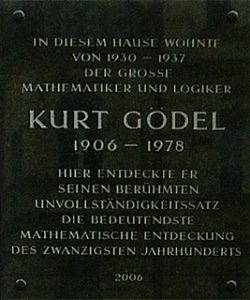
The text reads: „In this house the great mathematician and logician, Kurt Gödel, lived from 1930-1937. Here he discoverd his famous Incompleteness Theorem, the most important mathematical discovery of the twentieth century“. The reference to discovery is important as Gödel saw mathematics as existing indepentantly of human activity and thought. In philosophy of mathematics this makes him, like myself, a Platonist. Whilst today this view unfashionable, it is by no means incoherent and is still the view taken by a number of prominent mathematicians.
Despite its invoking the philosophy of Parmenides, I still feel that Humanese lacks a connection to something that is fundamental but undefined and over the years I have been tinkering with a mathematical formulation of what I am hankering for. This is based on the utterly baffling and unimaginable but nevertheless coherent concept of a surface of constant curvature. This is the opposite of a sphere but unlike a sphere, which is enclosed in space, a SCNC encloses space. Beyond a SCNC there is nothing, whereas beyond a sphere there is always the emptiness of yet more space. The SCNC is thus in many ways equivalent to the all-encompassing One of Parmenides, only being mathematical it can be made mathematically articulate itself using a variety of tricks worked out by top-notch mathematicians during the nineteenth century. Combining this with chaos theory leads to interesting insights which over the week, I formulate in the form of a poem. Whether any of this will make it into the exhibition (I have two remaining tablets whose content is so far undecided) I cannot say but for me at least, this supplies Humanese with the connection that was missing and a lost address has, so to speak, been found. This is nothing less than the address of God himself and the endeavour can be seen as continuing the direction begun by Cusanus. It is also the direction pointed to by the complex geometrical constructions identified by myself and others in the paintings of Piero della Francesca.
In the Ursula Chapel in Krems, Martin’s Am Sound Micro-tonal Music Festival kicks off with two new music landscape compositions by Günther Rabl one of which accompanies the voice of Alexandra Sommerfield as it meanders its way through a series of popular songs, while the other is accompanied by Martin Gut on gituar. The next day (3.9.2023) there is the Sound of Odem with Werner Puntigam playing a conch, Rabito Arimoto playing trumpet and bass clarinet and Günther Gessert as a guest on the Theremin. In these concerts, as with the SCNC mentioned above, there is a reaching out for and the finding of a connection with that which lies over and beyond us but of which we are nevertheless a part of. That there is more to this than just wishful thinking is shown by the fact that these are among the things that Martin and I regularly talk about.
2023, Week 37

Work proceeds apace on what in the El Très exhibition, will be the star of the show: a small gilded figure dancing in a copper bowl against a philosophical diagram that illustrates Parmenides‘ concepts of „The All-Enclosing One“, „The Great Divide“, and „The One pulling Itself back on Itself“, this latter being that introduces a degree of flawed unity back into an otherwise fractured world. This is of course heavy stuff but in philosophy, Parmenides is no fly-weight but rather a behemoth, who along with Heraclitus and Socrates, was a major influence on Plato. The significance of this is that, as Alfred North Whitehead has famously remarked, from Plato, the rest of western philosophy follows „as a series of foot notes“.
Further West, as a part of the „Schallwelle – Festival New Music Festival“ in Feldkirch, the musical version of Floundering is performed with the words being sung by a mezzo-soprano to the accompaniment of clarinet, viola, bassoon and piano under the direction of Antanina Kalechyts. Composer Martin Gut reports that the piece was received with much applause and afterwards people specifically praised the poem with the singer saying that the Humanese coda had something magical about it. Composer and librettist both happy!
2023, Week 38
The dancing figure is gilded and takes his place on the copper bowl.
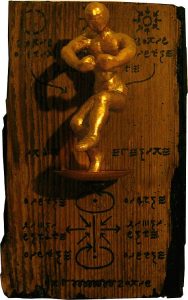
The poem of Week 36 is given a last polishing and finished, I decide to incorporate it into the El Très exhibition. Written in a miniature book it will hang from a tablet that shows the three kinds of surface that exist and the two kinds of space that they engender, Euclidian and non-Euclidean or hyperbolic space. To read the poem, click on the toggle title below.
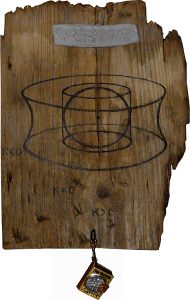
Poem: The El Très Pledge
Welcome to all those who would embrace humanism!
Words spoken tentatively on the breath of the wind,
hieroglyphs that cut out would but flutter in the air,
yet wound about themselves and joined together in space,
the form of a goddess may be made out, who gives and takes.
[to see the goddes, follow the link: „A Message from Willendorf“]
Yet behind and co-existing with the godly curves
there is in truth an inverted space, an inversion
of everything you know, the mere seed of an idea
that although but a seed encloses everything.
A space that beyond the bounds of imagination
is described by the mathematical symbols that
summarise the ultimate laws of all kinds of space.
The unimaginable space of which we speak is
summarised by a curvature of “less than zero”:
(1) K<0
[where K<0 is the Gaussian spatial curvature
of non-Euclidean Geometry which as an extreme
results in a Surface of Constant Negative Curvature]
Proven to exist by a law of endless growth, there
is a NUMBER that encapsulates and enshrines it:
(2) t = ∑ n=0-∞ tn /2n+1 = 0.412454033640…
[where tn is the nth term of the Morse-Thule Sequence]
Nevertheless it is also a proven fact that
such a space is beyond Cartesian space and so
contains the planes and axes of all coordinates
and all that in Cartesian space is imagined.
To give what is ethereal, shape and form in our world,
the surface of constant negative curvature is
forced through one of the planes that it itself does contain:
(3) K=0
[where the zero value of K denotes a Euclidian space]
Pushed through the rigid limits of a boundary circle:
(4) (x)2 + (y)2 = r2 [a formula for a circle]
the surface of constant negative curvature is
extruded in its length and compacted in its breadth:
(5) K=0: z2 = [a.sech-1 √(x2 + y2)/a) – √(a2 –x2 –y2)]2
[a formula for a solid known as a pseudo-sphere]
So that circles and spheres and straight lines can all be formed:
(6) K>0: (x)2 + (y)2 + (z)2 = r2 [a formula for a sphere]
Through the process of being stuffed through that which it itself
had once contained and curtailed, the ineffable is
written into the very fabric of our world with
there being good and bad, that which is and that which is not.
Equally, everything in our world is reflected
and appears in the other world as ideas that are,
by turns warped distortions, by turns
exact ideas of what on Earth is twisted and bent.
In this way the circle is squared and the square circled.
Like the other world, we are governed by the NUMBER,
the logic of the NUMBER being articulated
so that all processes, both of growth and of decay
follow laws prescribed by that which ever was and is.
Thus the two constants that describe all growth and decay,
with two added and four taken away, multiplied
as successive positive and negative powers,
(7) (a.dt), (a.d-t) [where a = a + 2, d = d – 4]
start out on a graph from the position “one, one” to
weave their way about the curve of a tractrix, the curve
which via the boundary circle defines the pseudo-sphere:
(8) K>0: y = a.sech-1 (x/a) – √(a2 –x2 ) [a formula for a tractrix]
and thus derives from the inverted negative curve
on the other side of the boundary circle’s limits.
And in the same way, always following but never
exactly matching, the ratios of music and
the regular plane figures of geometry do
also follow these patterns of order and chaos.
This may be seen when the laws of growth are converted
into modulo duo, with the unbounded growth
from beyond the boundary circle reappearing and
spelling out the logic of growth and that which is right.
Thus Parmenides’ ways of truth and opinion
are as true as they ever were, for the One of Being
is the surface of constant negative curvature
together with everything in Cartesian space.
In this latter we live out our lives according to
his way of opinion and seeming whilst that which doth
bind everything back unto itself and to the One,
is the pseudo-sphere, with its axes and poles, which reach
back and return to the One that which was diffracted.
Meanwhile the way of those things which Parmenides says
cannot be and cannot even be thought, can in truth
can be articulated and expounded despite
their being contrary to common sense and what we expect
and lead back to the unchanging seed of the One and
the changelessness with which all things in both worlds began.
For space is engendered by the very idea of
an extension-less point and a logical boundary.
Thus both positive and negative curves do gestate
and are engendered as back to back ideas that need,
imply and feed upon each other, their apparent
contradictions being only apparent and seeming.
And in the same way too, investigating the void
physicists find that far from being empty, a vacuum
is filled with entities and parcels of energy,
so that as Parmenides says, nothing is not and
cannot even be, only contrary to what he said,
the way in which nothing is filled with an energy
that exceeds all else, can be followed and leads to truth.
And with this we underwrite our pledge to use the words
of our language wisely and to strive for good and for truth
in all our doings with the world, nature and others,
for this unshakable truth underlies all that is.
[0]
[0110]
[01101001]
[0110100110010110]
[01101001100101101001011001101001]
[0110100110010110100101100110100110010110011010010110100110010110]
[…]
As if the excitement of the approaching exhibition is not enough, I find the lead that answers the question of, „Where, in the Burgesses‘ Hospice was the sculpture of Saint Vitus in a Vat originally displayed?“ This comes in the form of an overview of publicly funded renovation work carried out during the sixties and seventies on historic buildings. From the report, I learn that the vaulted arcade next to the bookshop in Krems, was once a closed off, interior space. This means that, not only was it a function suite of impressive proportions, it was also the space via which, from the Burgesses‘ Hospice, the Hospice Church can be directly accessed. Placed at the centre of the room, every day, those who lived and worked in the hospice will have passed by the image of the healing saint. See the article, The Triangle and the Saint from Krems for more.

2023, Week 39
With the opening of the exhibition at the end of the week, I distribute the last invitations and spend a whole day hanging. The next day I complete the final piece which I deliver that evening. Martin is keen that a work of mine should also hang in the Ursula Chapel, in Krems, which is the main venue of the Am Sound Microtonal Music Festival. The chapel is a hidden Gothic gem that is not usually open to the public and I cautiously suggest that the piece made for Volary might be suitable. This is appropriate not only in itself but also because in the El Très exhibition there is a smaller version. Showing him a photo of the Volary piece he immediately agrees and a few days later we transport the work to the chapel.
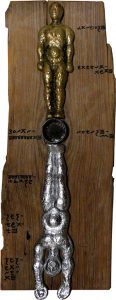
On the day of the opening, I decide to read Floundering along with its Humanese coda and another fragment in Humanese. Reading the texts out loud I am only slowly able to reconnect with the cocktail of sounds and rhythms that I had devised months before and only then am able to begin the rehearsal proper. At the opening, I introduce the Humanese project, recite the poems. I then go on to explain how Humanese is designed to re-emphasize that we are emotional beings and how, following Parmenides, reason is a cleaver that cuts the unity of all that is into pieces so that we may manipulate it. Nevertheless at the end of the day, we are but fleeting presences, let loose on something much greater we can ever imagine. All this is greeted with interest afterwards, a number of people express the hope of hearing more in Humanese!
The theme of turning the world upside down and of re-inventing much that we take for granted is then continued by Hans Tschirisch and Pamelia Stickney, with Hans Tschirisch singing arias from well-known operas such as Carmen and The Magic Flute using his own style of overtone, or throat-singing. In throat-singing the singer produces a gutteral growling noise from which overtones are also emerge and which can be modulated. This style of singing is prevalent in Tuva and is a part of the region’s shamanic culture. While Tschirisch accompagnies himself on guitar and cymbals, Stickney provides bass and additional percussive support on a celloino. In these interpretations, the fun is of recognising the well-known behind the radically changed interpretations and I see the renditions as complimenting the playful Eresine Tablet, The Senses as Arts.
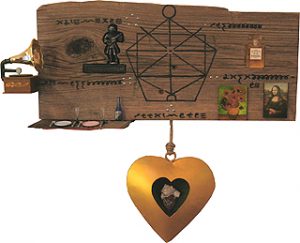
Tschiritsch also makes instruments of such things as pedal-powered sewing machines and bath tubs. For photos with acoustic samples, see: https://www.tschirisch.com.
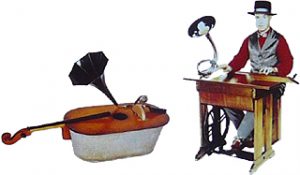
Meanwhile Pamelia Stickney is a virtuoso theremin player. See: https://www.pameliastickney.com.
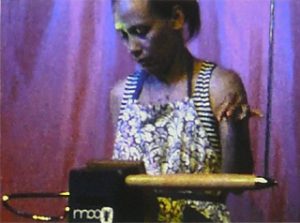
2023, 1st October
The next evening I find that Martin’s curator instincts are correct and that the Volary piece and El Très exhibition are indeed admirably augmented by Kyle Gann’s Hyperchromatica. In New Music, Kyle Gann is a major figure. Hyperchromatica is a three and a half-hour piece composed for three computerised-player pianos. These are re-tuned so as to have 33 pitches per octave with the overall result being equivalent to a single piano with 243 keys. Apart from the fact that a human player’s hands would not be wide enough to span the keys in the ways required, there are also poly-rhythmic structures that beyond what a human player can do. Nevertheless conventional tuning is also features in the work and in fact only a quarter of Gann’s ouvre is micro-tonal. In the selection performed in Krems (using a computer and three seperately channeled speakers as there not enough disklaviers available in Austria) there is always feeling that behind the pianos, there is a definite and distinct human presence. Concerning Hyperchromatica Gann says:
„I’m trying to make micro-tonality attractive and seductive, not scary as it is to most people and in most micro-tonal music. I want to suggest (and prove) that we can keep conventional music and augment it with higher-overtone relationships. The simpler context, the clearer micro-tonality’s potential becomes. This is my strategy for bringing micro-tonality into the mainstream, where I am convinced it will eventually end up. The goal here is no less than to re-invent tonality.“
Hyperchromatica is thus a beguilingly intwoven mix of conventional and micro-tonal tuning in which the humanly possible and impossible are combined to result in an opulent series of refracted and defracted „moonlight“ sonatas. See: https://www.kylegann.com. Here the planetary metaphor is appropriate as whilst composing the work (2015-2017 & 2020-2021), Gann did have the planets in mind, particularly the 2:3 resonance that pertains between Pluto and Neptune, with this ratio also featuring in my Volary piece and with Gann’s Geometry likewise providing a related and relevant counterpoint: https://www.kylegann.com.
2023, Week 40
Often, after the opening of an exhibition there is the danger of falling into an empty void of nothingness. Overnight, all the excitement vanishes and is replaced by the drab world of a present where nobody cares about anything and everything fades inexorably to grey. The advantage of being involved in a music festival is that this doesn’t happen as there is so much else going on. Through the music I have heard and the people I have met, I find that I am enable me to see what I have done in its true context. In the exhibition, the development of Humanese and my forays into mathematics, the puzzles and mysteries hitherto only alluded to in my work, are now pin-pointed and are elucidated in ways that were not possible before. This not only endows (as before) the mysteries of life and being with meaning but provides us with a more detailed and up to date address than those inherited from our forbearers. This in turn behoves us to accept that with life and higher-order consciousness, there are responsibilities that it is our duty to accept. In effect, I have finally achieved what I set out to do forty years ago. After much searching, many meandering’s and a few false turns, I have assembled the full palette tools and techniques that I had all along been looking for but which proved so hard to find. As shown in El Très, these techniques enable the spuriously erected boundaries drawn up between art, language and philosophy to be dissolved and it is this dissolution I realise, that has the capacity to break the deadlock that currently confines us. While art and music show that things can be done differently, without philosophy and a rigorously worked out conception of who and what we are and of our place in the world, they will only ever be forms of entertainment that by making promises, hint at something without ever delivering and this is precisely where the combination of philosophy and Humanese fit in and provide what is otherwise missing.
2023, Week 41
Finally I return to the long neglected kouros project of Weeks 4-6 and know that leaving the work with an impressionist finish is a soft and easy option that is not acceptable. The work is a kouros and Canon, this latter term coming from the Classic Greek sculptor, Polykleitos, who made a work entitled Canon and also wrote a book that bore the same name. Of this work, only fragments have survived. Of these fragments, some suggest that Polykleitos had an aesthetic canon of proportion. The untranslated and now forgotten work of the architect, Ernst Mössell, also suggests that during the Antique there were very clearly worked out systems of proportion in use. Although I have all the texts on proportion written by artists and architects during the Renaissance and have discovered the system of proportion used by Piero della Francesca (article forthcoming), in my kouros, the system I am really drawing from is a more recent canon of my own divising. This is a futuristic figure drawn within a square through the construction of arcs based on divisions of 1/2 and the Golden Section. Though I did not know it at the time, this system which dates from 1983 (the year I left school), is related to a system devised by the Renaissance artist, Erhard Schön.
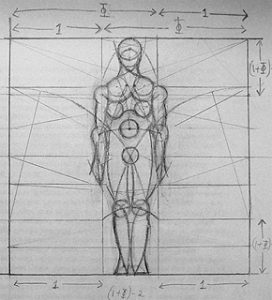
All this being said, my kouros/Canon project is not so much about propotion but as the drawing above suggests, with something more basic. It is about the stylisations by which a male human figure might convincingly be realised in three dimensions. This is sketched out in numereous drawings and small pieces I have done over the years. Nevertheless as soon as one begins making larger pieces in three dimensions, new questions arise and everything must be re-assessed. Strange though it may sound, making a naturalistic figure in the round is not just about anatomy, it is also about abstraction. This is because for any pose that one cares to depict, one must find a combination of forms that communicates what the pose is about. Here absolute naturalism is only one of a number of options and is only one part of an equation of which with abstraction is the other. A carefully devised (or rather arrived at) combination of abstracted forms often says more than a slavish copying from nature. In addition, behind any pose held by a figure, there is an associated mental state that the pose implies and in as far as the work intends to go beyond mere formalism, this is what the work is really about. Here abstraction comes into its own and while nature is important, simplification through abstraction is the essential and underlying means of communication.
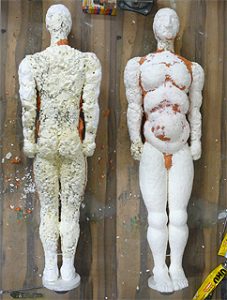
Happily I find that when completely dry, Fimo Light is surprisingly hard and responds well to treatement with a rasp. In the above, the left-hand view of the back of the figure shows the chicken-wire filled out with trimmed window mounting foam. Meanwhile the frontal view on the right shows the figure in a more advanced state, with all the forms apart from the right hand, rendered in Fimo and with many being complete. The colours are a result of different colours of Fimo being used at various stages. This because in the winter, when there were shortages of things due to supply chains being interrupted, when buying Fimo Light I had no choice but to buy up all that was available regardless of colour. As the work will be wheather-proofed and painted, colour differences at this stage are irrelevant.
In Vienna, the Kunsthistorisches Museum has a fragment copied of Polykleitos‘ Spear-bearer which is reckoned to exemplify his Canon. There is also a stunning head of Hermes that is copied from a Hercules and a relief version of his Dying Amazon. See: https://www.khm.at, https://www.khm.at and https://www.khm.at.
2023, Week 42
At Edinburgh College of Art where after a Foundation Year, I did First Year Sculpture, the studios were lit with outside northen light which was more gentle that the harsh light from the South and was thus better at revealing the subtilties of form. In my subterreanian studio in Stein however, I have strip lights – for an artist the worst form of lighting imaginable and for a sculptor potentially disasterous, as the garish light tends to dissolve and hide rather than revealing them. Yet for me, seeing forms as accumulations of curves means that I can monitor the forms I am making via the profiles they generate. This not only enables me to work with strip lightening, it also means that I do not get cold, as like a jack-in-the-box I am constantly moving about, watching the changing profiles and checking the flow of lines.
As work proceeds, I decide to make the muscles and abstractions thereof more pronounced. This means that at the back, I need to fill out the volume of the shoulders with additional window-mounting foam as otherwise there will be so much Fimo that it will take weeks to dry. The image below shows the extra window-mounting foam before trimming.
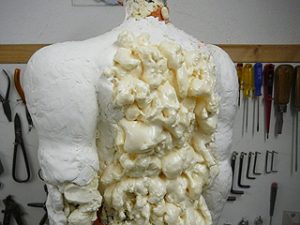
On a different and yet related note, in Nele Pollatschek’s Dear Oxbridge – a Love Letter to England (unfortunately only available in German) I read a razor sharp analysis and insider account of Oxbridge and of how at public schools, the clever are trained into getting into Oxford and Cambridge. Once there they are then drilled into learning how to get the gist of things very quickly. This stands them in good stead when they enter politics and apply for jobs in management positions and for decades has arguably served the country well enough. Yet as modern life gets more and more complex and abstracted from basic realities, the system and the cleverness of the high-achievers it produces, results in leaders becoming alienated, not only from the wisdom of common sense but also from the day to day realities of the people they are supposed to be leading. For Pollatschek:
„The ideal of an Oxbridge education, particularly in the humanities, is not learning how to work scientificly or of acquiring competance in a certain subject, rather it is the cultivation of an ability to be able to talk about almost anything, in such a way that one can manipulate it to one’s advantage. This is what makes Oxbridge graduates so successful in areas other than what they studied. Whoever studies at Oxbridge learns not so much the methodology of a discipline but instead how a large amount of information can be quickly processed so that eloquent and innovative observations can be made. This ability predestains Oxbridge graduates for a large number of occupations: for journalism, where continually new themes must be grassped, for politics, where expert opinions must be quickly understood and actions decided upon and indeed any position of leadership where decisions must be made concerning things that one only partially understands and often cannot execute oneself. At the same time of course Oxbridge graduates are predestained for talking about things where their understanding does not reach to the heart of a matter, only unlike others, they can wax lyrical on the subject. Above all, what one learns at Oxbridge is how to appear knowledgeable.“
The theme of out of hand cleverness and the humility of genuine understanding is the subject of the El Très relief shown in Week 39. In the work, a distinction is drawn between iotiseme and boinioke. Where the former refers to real understanding, the latter designates superficial knowing. Where iotiseme is associated with and leads to eniapse, which is the contentment of genuine wisdom, boinioke is associated with sastakte, which is depression. This is because when the bubble of cleverness bursts (as bubbles invariably do) there is nothing left but an empty void – for which the clever are however utterly unprepared. All this flows into the kouros figure, as he stands for something which his abstracted forms intimate and prepare him for. Equiped with values that are not for sale, he sees clearly and his body is ready for the challenges that he has resolved to take on.
2023, Week 43
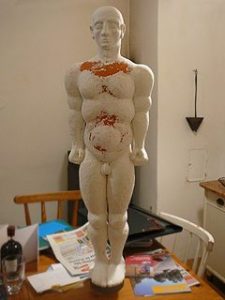
Carrying the work from the cellar up to the kitchen so that it can harden quicker, I see in the softer bulb light, a number of unpleasant irregularities that will need correcting. These I decide to correct in the garden under natural light.
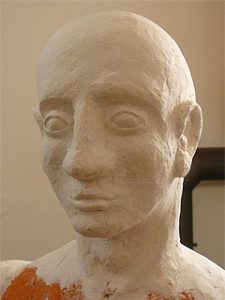
Seeing the work in the kitchen, the question of a title becomes all the more pressing and I feel the need for a textual context.
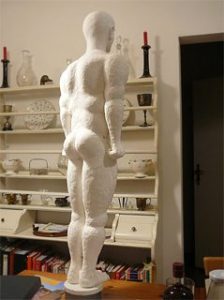
In the Kunsthistorisches Museum in Vienna, an antique sculpture springs to mind. This is The Youth from Magdalsburg which has an inscription on its thigh: https://www.khm.at. Found in 1502 in the Austrian region of Carinthia, the work was included in a book of inscriptions published in 1534. The inscription records that the freedmen, Aulus Poblicus Antiocus Tiberius Barbius Tiberianus, donated the work to the temple at Magdalensberg and the work is a Roman copy of a Greek original and as such is the embodiment of a canon such as I have been working on.
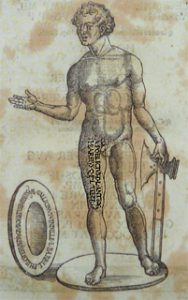
Although I have reservations about an inscription on the thigh of my figure, I work on a text in Humanese:

perpe etpipoizosa
enay zinias biboiae,
biboiae zinias sinassas.
This translates as:
A program of work
is in any action,
any action is a deed.
This supplies the title, Perpe Sinassas or „Program Work“ and the words I realise, belong on the muscles of the shoulder-blades.
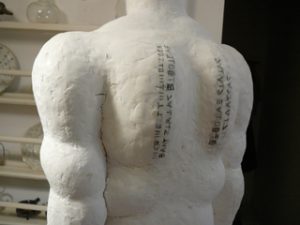
2023, Week 44
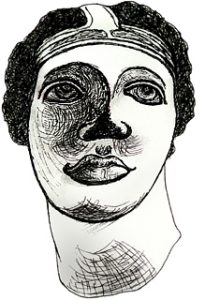
Reworking the texts and illustrations of the guide to Parmenides that is soon to be made available as a print on demand book, I decide to use my translations of the poems of Sappho as an illustration of the Archaic notion of truth that is central to Parmenides‘ philosophy. Thus as I work on the lay-out and final texts of the book, I am also busy producing images of Sappho. These I draw from photographs of statues and reproductions of vases. This not only provides continuity to the work (as all images are by the same hand) it also absolves me of copyright problems. Departing from a damaged portrait of Sappho in Istanbul, I slowly work towards an image of the poet that, perhaps encapsulating something of who she was, also speaks to us now. In fragment L-P 2, Sappho invokes the goddess of love, Aphrodite:
(…)
Come hither to your sacred temple
and secretly manifest yourself,
unknown pleasures await you: a grove
of apple trees and an altar of
smoking incense.
Beneath apple branches cool water
chuckles and everywhere is shaded
by roses and foliage flutters
on the wind’s breath.
In the blooming meadow, horses graze
amid scented flowers and the wind
smells of honey.
From Cyprus we beseech you to come,
ambrosia in golden vessels
to mix and dispense with the nectar
that celebrates.
In addition to combining the text and images and working on the cover of the book in the section on Parmenides, I add an extra chapter on how ultimately, behind modern physics there is the One of Parmenides, the Logos of Heraclitus and the principles of the Same and the Different expounded by Plato in his Timaeus. I also realise that before the book becomes available, I must clarify a number of issues concerning the topography of Elea, particularly the sacred spring or hyele from which the town derives its name.
2023, Week 45
With the planned series of Reloading Humanism Guides in mind, I visit the Buch Wien book festival where I pay a call to the Buchschmiede, or „Book Smithy“ – the most likely candiates for publishing the series in print-on-demand format in the German-speaking world. After a helpful chat everything is clarified and I leave with bag of freebies and a sample of the different papers available. The next day I set up an account and the publication process starts…
After the excitement of his Am Sound Microtonal Music Festival, for Martin there is something new on the horizon and a composition by him has been selected as one of 70 works to be performed at the International Society for Contemporary Music Festival 2023. Prompted by the visuals of my own news page, I prepare a grafic image for him for use in the local papers.
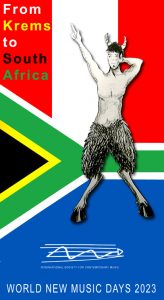
This year the festival is to be held in South Africa, from 24th November until 3rd December, with the date for the performance of the string piece, Such a Delightful Thing… not yet fixed. See: https://iscm.org for updates.
2023, Week 46
The uploading of data at the Book Smithy begins with an author’s name and ends with a ready to print PDF. In between there is the title and all-important the text for the back cover, the genre of writing along such questions as the intended format, whether the book is to be soft cover or hard cover, et cetera. Uploading texts and answering these questions prompts further thought and over the week things change. Thus instead of being, „Parmenides of Elea, Sappho of Lesbos“, the title becomes, „Questing for Truth: Parmenides of Elea, Sappho of Lesbos“. The title decided upon, I request an ISBN along with a bar code for the back cover and fifteen minutes later the number arrives and is immediately pasted in. The Reloading Humanisn prism suggests itself as a graphic counterpoint and as I type in the site’s URL, I feel the cover is finished.
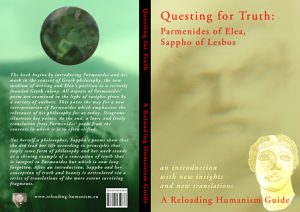
Over the weeks, I have struggled to arrive at a portrait of Parmenides that is closer to the Roman portrait in Elea than the image I have so far been using (see Week 34). The problem is that what works in medium format becomes unconvincing when reduced in size. Despite having splattered a carefully drawing pen and ink drawing with gouache I am still not satisfied and finally realise that the portrait must have eyes. These I take from the old image and at last I find a satisfactory image looking out at me.
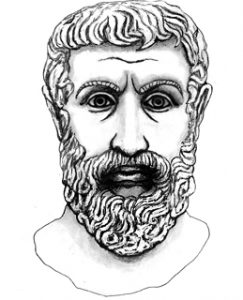
The Roman portrait of Parmenides is on display in Elea in the Palatine Chapel on the town’s Acropolis and although it has pupil-less eyes, it works because it is an in-the-round image, with the weight of Parmenides‘ presence being communicated by the physical presence of the worked-marble forms. In the case of a small-scale frontal image on paper, this is not the case and suddenly where a presence is expected there is only an inappropriate absence that irritates.
2023, Week 47
While work proceeds apace on the formatting of the Parmenides-Sappho book, I also return to issues raised in Week 28. This is prompted by plans to hold a Burns Night supper and I see that deep, deep down, the two are related. This however is a long story that involves the calendar, the nature of winter and the way that something can come out of nothing. Although Burns was born on 25th January, I see Burns Night as a modern substitute for a much older festival that was held at around the same time. Dividing the year into four by taking the winter and summer solstices and the spring and vernal equinoxes results in the four seasons. Yet for those living in the country and leading a life that is related to agriculture, further divisions are needed. These are arrived by dividing each of the the four seasons into two equal-length periods. Thus the 90 odd days between the summer solstice (20th/21st June) and the vernal equinox (20th/21st September) are divided to result in a festival that is held at the latest on August 8th. This is the festival that celebrates the beginning of the harvest season and which was known to the Celts as Luchnassad. In between the almost 100 days that separate the vernal equinox and the winter solstice (20th/21st December) there is Samhain on the 8th November, whilst between the 90 days that separate Samhain from the spring equinox, there is Imbolc on (at the latest) 8th February. Between this day and the summer solstice there are 92 days, which divided into two results in a festival on 8th May.
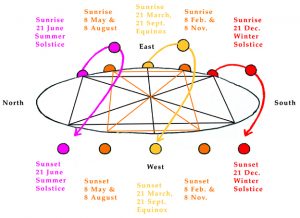
For thousands of years, all these occasions were celebrated with festivals. With the introduction of Christianity, the festivals were re-named and the customs associated with them were celebrated in uneasy conjunction with Christian practice. Thus Samhain became All Souls Day, Yule became Christmas Day and Imbolc became Candlemass whilst Beltane was secularised to become May Day.
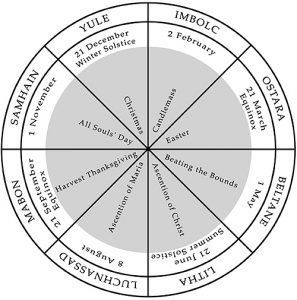
With the intolerance that the Reformation and Counter-Reformation brought, the non-Christian elements were stamped out and subverted so that they now only survive as quaint folk customs that nobody understands. In Scotland, the low-church Calvinism that the Reformation gave rise to, resulted in no replacement being proposed for Imbolc and the psychological need for a festival between Christmas and Easter was only met at the beginning of the nineteenth century through the introduction of Burns Nights. Thus behind the honoring of the poet Robert Burns there lies a celebration of the time when, in deep mid-winter, the days begin to get longer and traditionally, the corn for the coming year was planted out. It is also at this time that, on sheep farms, the ewes are heavily pregnant and lambing is imminent. It is therefore not surprising that at Celtic celebrations of Imbolc, the fire and fertility goddess, Brigid, was venerated. In the Celtic pantheon, Brigid was one of the most powerful gods and for the Celtic farmer, this makes Imbolc and not Yule, the most important winter festival. As Brigid has two two sisters who are also called „Brigid“, this is a clear indication that behind the Celtic goddess, there lies the great goddess of the Neolithic, who as an embodiment of the year and the cycle of the seasons, was seen as having three forms, these representing spring, summer/autumn and winter. In human guise she was thus maiden, mature woman and old hag but she also adopted animal forms and with a human body, was depicted with animal and bird heads appropriate to the season.
To provide some flexibility in arranging dates for a Burns Night, I set the period between Burns‘ birthday on 25th January and the end of the last week of February. This latter date, combined with appropriate anniversaries at other times of the year makes the 7th of the month the „last possible day“ for the celebration of Imbolc/Burns Night. Interestingly the first Burns Night was held on 29th January, 1802 and it was only over the course of the year that Church records were consulted and the correct date of Burns‘ birthday was established. The other anniversaries in the yearly cycle are: the apocryphal day on which Plato was both born and died (7th November), the day the Scottish philosopher David Hume was born (7th May, 1711) and the day when the Venus of Willendorf was found (7th August, 1908). On the Kreuzberg that overlooks Krems and Stein, at the point marked by the life-size wooden crucifix, these days, along with the days of the solstices, are marked out by hills and features on the horizon, over which and behind which, the sun rises and sets.

To anchor the Burns Night in the landscape and in the calendar, I identify points on the skyline which coincide with the sun’s rising and setting on the 25th January and at the beginning of February. As fate and fortune would have it, the angles at which these points lie away from due South are the very angles which, along with a 60° angle that points North, form the 13,14,15 triangle that marks out the plan of the sculpture, Saint Vitus in a Vat, held by Museum Krems.
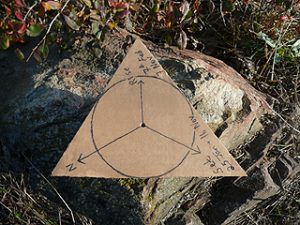
The triangle can either be placed on a rock at the foot of the cross, or held at eye-level and aligned with the intended landmarks. North is marked by the second dip away from the top of a hill called The Kuhberg:
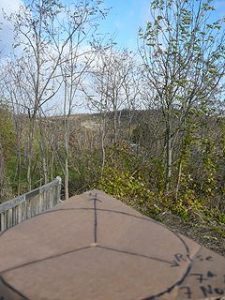
On the 25th January the sun sets at the point where the Pfaffenberg cuts the hills in the distance:
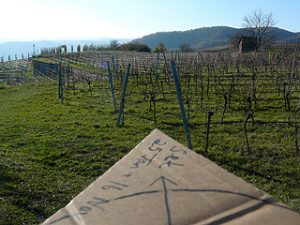
At the beginning of February it then rises from out of a series of stepped hills, on one of which a chapel has been built:
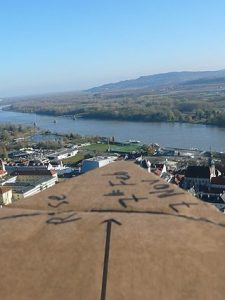
Appropriately, Weathercross Chapel is an example of a heathen site being Christianised through the erection of a cross in the fifteenth century. Quite possibly the heathen rituals practised there, were practised (all be it in modified form) right up until the Counter-Reformation and they may very well have been related to the sky and weather, as the hill is frequently struck by lightening and after the erection of the cross, the spot very quickly become a place of pilgrimage that was sought out by people seeking protection from storm damage.
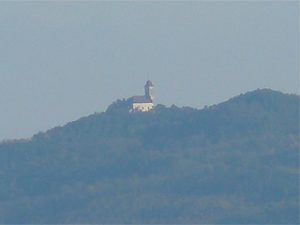
By 1661, a small chapel had been built and the site was visited by 3500 pilgrims. In 1727, the chapel was enlarged through the addition of the nave and tower that mark the skyline today. Between 1729 and 1782, there was a hermitage in the immediate vicinity. Leading up to the church there are representations of the stations of the cross with the crucifixion being above the altar inside the church. This latter was carved in wood by the first hermit in 1736. From the cross on the Kreuzberg, other alignments mark out other dates, including the solstices. All this is however, not only rough and ready but is also partly based on the notion of a flat horizon which is of course not what I have before my eyes. Thus over the course of 2024, I will need to check the alignments.
2023, Week 48
Not forgetting the coat of arms with which the conceptual considerations for the holding of a Burns Night began, I have also been working on adapting the arms for a blazer badge. As the intended background is black, this involves a not inconsiderable amount of work with many outlines having to be adapted and the letters needing to be enlarged by 30%. For the original drawing see „Contact – De re juridica“ which is on the Mission Page below the Blog and Shop pages.
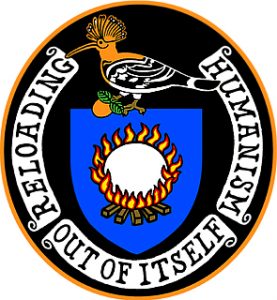
At Reloading Humanism the cycle of the seasons is symbolically encoded in the initiative’s coat of arms, with the hoopoe bird, the apricot and the motto, „from out of itself“, all referring to the events that structure the year. Like many birds, the hoopoe bird is migratory and is only in Europe from April until October. With the bird’s departure the sun continues to sink ever lower in the sky until at the winter solstice it reaches a nadir from which, as if „from out of itself“, it then recovers so that it may once again begin to climb progressively higher in the sky and usher in a new year with new seasons. Although the end of January/beginning of February is still deep mid-winter, the days are beginning to get longer and as seen, it was at this time that the corn for the coming year was sown out. Referring to the heavily pregnant ewes, „Imbolc“ means „in the belly“ and despite the apparent lifelessness all around, beneath the surface, something is beginning to stir. Venerating the signs in the sky, the sowing out of the corn and the pregnant ewes by eating a haggis and reciting Burns‘ Address to a Haggis is thus a ideal way of reconnecting with the cycle of the seasons and the rhythms of nature. On the coat of arms, the return of the sun’s lost radiance is further hinted at by the apricot that the hoopoe bird holds. Called by the Ancient Greeks, „prakokion“, apricots were also known as „golden eggs of the sun“, whilst botanically, the apricot is also seen as engendering itself „from out of itself“ as it is self-fertilising and will bear fruit without the need for pollen from another tree.
That there is much more going on here than the mere balancing out of concepts and ideas with symbolic counterparts is shown by the fact that Christmas is celebrated on the wrong day! Traditionally, Christ, the Son of God and Light of the World, was associated with the sun, with churches being built facing East so as to face the rising sun and the Saviour who arose anew each day. Christ’s birth was thus equated with the emergence of the sun from out of the nadir of the winter solstice. Confirming the analogy, The Bible says that when Christ breathed his last, the sky darkened over, this implying a partial eclipse of the sun. These analogies mean that Christmas ought to be held on 21st December, the day of the winter solstice. The problem is that in The Bible it is says that, in accordance with Jewish law, 40 days after Jesus‘ birth, Mary purified herself in the Temple. The festival commemorating this event ought therefore to be held exactly 40 days after the winter solstice on 30th January and yet instead, Candlemass is held on 2nd February. The reason for this can only have been that Imbolc, the festival that Candlemass was to replace, was so important that no one dared move it forward, not even by a few days. The young and un-established Church therefore had no choice but to move Christmas away from the day of the winter solstice and postpone it until 24th December, so that exactly 40 days later, Imbolc/Candlemass could be celebrated at the right time.
2023, Week 49
Although the idea that during the Neolithic, from places specified and defined by the building of structures such as enclosures and stone circles, points on the skyline were used as markers by which the sun’s yearly journey through the sky could be kept track of and integrated into a mythological narrative that offered some kind of explanation, is finding acceptance, published case studies are hard to find. In Scotland however, I have just such an example, with a compelling range of alignments, a holy well immediately below the enclosure and a folk custom that is practised in the village below at the beginning of February and which may well refer to the sowing out of the corn and the striking alignment that occurs at the beginning of February/beginning of November.

Seen from the center of the enclosure, on the 6th February the sun sets between two hills in the distance as indicated by the arrow in the image above. Despite attempts at photographing the event, the weather has so far not cooperated and the project of capturing a striking image is on-going. Although this and the other alignments that the site offers would appear to make an impressive case, there is no archaeological evidence to prove that the enclosure dates from the Neolithic and so the argument that the structure dates from a later period hangs in the air as an irritating doubt that cannot be entirely dismissed.
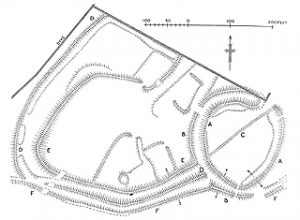
During a week’s holiday in the Scottish Borders, my brother and I, taking advantage of the winter lack of undergrowth, investigate a structure that he has identified using light detection and ranging images (LiDAR). In this new technology, aerial scans of the ground are made using the light reflected from lasers which are then processed in a way that results in all above ground semi-transparent features such as trees and vegetation being removed. This enables hitherto unknown structures not marked on ordinance survey maps to be detected and scans that cover the whole of Scotland are accessible on-line. The structure my brother has identified is a fortified settlement that is probably of Medieval or Dark Age origins. The settlement is probably the same as one mentioned in the area in 1580 and confirming this, the oak trees that cover the site although several hundred years old, are not older than 500 years. The next day, my father and I investigate Brugh Hill near Hawick, on the shoulder of which there is a stone circle whilst at the top of which there is an Iron Age fort. Emerging from the mist as we climb up, this latter is an impressive structure with defensive that whilst practical are also symbolic. Re-examining the enclosure on the shoulder of Bonchester Hill, I realise that although the case for the structure’s being Neolithic is compelling, it is nevertheless circumstantial and that in any written publication hard facts evidence is essential. Having done a considerable amount of work on the solar alignments associated with this site I am loath to see my efforts fade to nought and so once again find the ball back in my court with the onus of proof on my shoulders. As proof (and equally dis-proof) could be supplied both by taking core samples and by digging a trial trench across a ditch (both of course requiring Historic Monuments and landowner permission), the problem amounts to the costs of analysing core samples versus the costs of digging a trial trench and I decide that this is a task for 2024.
Apart from trapsing over Border hills, during the week I am also busy with locating and retrieving from storage, four objects that I have chosen as emblems of the four seasons. The purpose of this is to set up a corner or space where, when I pass by, I am reminded of the year and of how it is embedded in the landscape where I am lucky enough to live. The four objects are, for Imbolc (and Burns): an ingeniously designed candlestick from the eighteenth century, for Beltane, a lump of raw glass to represent the pristine newness of spring, for Luchnasad, a barrel for the harvest, whilst for Samhain I choose an hour glass. These objects I plan to display in conjunction with the 13,14,15 triangle that, via the rising and setting sun, indicates the days between which the planned Burns Night is to be held. Although I have the cardboard triangle of Week 47 in Scotland with me and can place the objects on it as intended, I am repeatedly beset with doubt, both as to the point of the worth of on the enterprise as a whole and with regards to my choice of objects. Nevertheless, persevering, along with a single malt whisky from the Isle of Arran, I pack the objects up for transport.
2023, Week 50
Back in Stein, I unpack and scout the house and cellars for a place to set up my ritual corner and it is only after I have gone through a number of possibilities, that an obvious and under-used console table in the hallway comes to mind. The idea is for the 13,14,15 triangle and its enclosing circle to act as a base for the object of the season that is to be placed on the table. Making a 1:1 copy of the cardboard triangle of Week 47 in wood, I mark out the angles and label them, only to find that the triangle, positioned on the table, appears naked and bare. Moreover when visitors come, I realise that I will be repeatedly called upon to explain the triangle and its significance in situations that are too casual and so for me, inappropriate. I therefore make a covering and fate having in any case already cast its blessing on my endeavor, find that not only is the covering exactly the right size for the table but that also, an un-used, fluted round collar I have in the cellar, exactly marks out the circle that the triangle encloses.
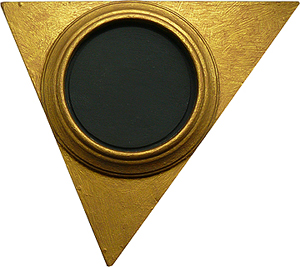
As observed, this triangle lies behind the composition of the sculpture, Saint Vitus in a Vat, made by an anonymous sculptor in around 1520 and now held by Museum Krems. The 13,14,15 triangle enclosing a circle would appear to be have been taken from the last exercise of Piero della Francesca’s Libellus de quinque coribus regularibus (see Week 15 for a diagram). Turning the triangle over, I write a riddle on the back:
THIRTEEN, FOURTEEN, FIFTEEN BUT WHERE IS TWELVE? WHERE IS EIGHT? AND HOW IS THAT WHICH THEY CALL THE GOLDEN SECTION TO BE CONSTRUCTED FROM THIS TRIANGLE?
The words form a square which I then partially surround with a circularly arranged row of letters. These pose a further question:
AND HOW THERE WITH MAY A CIRCLE BE SQUARED?
The answers to the first two questions are given by Piero della Francesca in his Libellus, whilst the answer to the third is not given at all and indeed the question is not asked as such but rather is alluded to, through the otherwise inexplicably illogical way that Piero has organised the last tract of his Booklet. This sounds over-interpretative but people of the Renaissance loved puzzles and hidden allusions that had to be identified and searched out. During the course of 2024, the case for this argument (along with the missing answer), will be supplied when an article I have written on the Saint Vitus sculpture is finally published. Meanwhile the answer to the fourth question will be supplied in another article that may well not come out until 2025. This will give the otherwise missing link between Piero della Francesca’a art and his mathematics. After much effort, via a series of riddles and objects on a console table, I find myself at last relating to the place where I live, the cycle of the seasons and to the higher mysteries life, art and mathematics as given form by Piero della Francesca. The underlying themes identified, I think that it only remains for the objects I have chosen to be introduced. Yet the introduction begs words and so once again, I am compelled to write.
2023, Week 51
Like the new moon which is never seen, during winter, the sun was thought of as gestating and renewing itself in the longer nights that its descent in the sky precipitated. Although when seen alongside the insights and achievements of planetary physics, the idea of the winter sun and the new moon renewing themselves during their periods of invisibility appear as hopelessly out-dated metaphors for what is actually going on, nevertheless they are pointing to something deeper. This is the question of how something can come out of nothing, with the rub of the matter being that, as modern physics has found out, there is in fact no such thing as nothing. The nature of the supposedly empty void that was postulated as lying between particles of matter has brought modern physics back to fundamental problems wrestled with by Plato, Heraclitus and Parmenides. This concerns the nature of change. When something changes, part of it remains the same and part of it becomes something else or becomes absent. In our day to day lives, atomic theory solves the problem of change admirably. The problem is that when one starts looking behind the protons, neutrons and electrons of which atoms are constituted, things start to get difficult and questions arise concerning the energy that during change, appears to disappear. Thus during the course of the twentieth century, it was discovered that although a vacuum contains no atoms, it is far from empty and in the apparent emptiness, there are huge amounts of energy. As these are not always distributed uniformly, dense patches can arise and physicists now see our universe as emerging from out of an endless and infinitely expanding multiverse as a supra-dense, supra-hot crystalline structure whose ultra-ordered nature was shattered through the emergence of a tiny flaw. This resulted in an explosion that brought the space and time of our universe into being.
Proceeding from a state of maximum (and unsustainable) order towards a state of maximum (and by and large sustainable) entropy, our universe is ultimately fated to dissipate into a mass of elementary particles and in this way be absorbed back into the nothingness (that is not nothing) from whence it came. To give my account of the cycle of the seasons the desired degree of mythologically flavored but science-derived twist, I decide to draw parallels between the life-cycle of our universe and the cycle of the seasons. This I see as as being fundamentally important as although the narrative provided by physics of how our world and universe came, is spectacular and impressive, it has no hands-on aspects to it which our feelings and intuition can relate to. My feeling is that relating the modern narrative of the Big Bang and a multiverse to the cycle of the seasons will solve this problem. Although the going is not as straightforward as expected and I fill several pages of my sketch-book with notes and drawings. As I work, I realise that what I am doing is precisely the same thing that the early Christian Church did when it was trying to establish itself amid skeptical pagans. The straight line of Christ’s life was taken and woven around the cycle of the seasons to make a yearly repeating narrative that people were able to lock onto. This gives a form of temporal embodiment to the identification of Christ with the sun. Every year Christ is born at Christmas, dies on Good Friday and then rises again three days later. Regardless of whether we believe it or not, this equation structures our lives and influences our thinking. Harnessing the habits that cluster around the rhythms of the changing seasons is thus a potentially useful tool in giving form and body to a story, that is otherwise distant and abstract.
Applying these insights to the narrative of the Big Bang, the time of the winter solstice stands for the multiverse with which everything begins. Amid the dark randomness, a patch of ultra-order emerges. The supra-hot, supra-dense, perfect structure then acquires a flaw, with the flaw being what is celebrated at Imbolc and being equivalent to the sowing out of the corn and the pregnant ewes. At Ostraca, the flaw results in the Big Bang and the exploding universe is seen as an egg. This is because the universe is not only unimaginably hot, it is also unimaginably dense. There is space but there is no such thing as empty space and the super-symmetry of the original structure is still very much present. The egg is thus to be imagined as an expanding egg from which empty space as we known it has yet to emerge. Self-contained, at each stage of development, the changes taking place change the system and the way it operates. After the stage represented by the egg, the cooling temperatures and expansion result in the universe becoming a quark-gluon plasma. This is represented by a lump of raw glass and is equated with the youthful growth of spring and the festival of Beltane. As the universe continues to cool and expand, not only are new processes are initiated but old ones are stopped. Equated with Litha and the summer solstice, one of these processes results in particles and their corresponding anti-particles cancelling each other out. This eliminates huge amounts of matter. When cooling temperatures stop the process, not all particles have found their corresponding anti-particles and a small amount of mass is left over. It is out of this remainder that the matter of our world is made. These changes and the continuing cooling initiate a new phase in which other particles and antiparticles destroy each other. As a part of this new phase, empty space is engendered through the coming into being of particles that can exist at a distance from one another. This phase I associate with the summer solstice, with a sun-like object made of resin to represent it. Equated with the Luchnassad of harvest, there is a third and final process in which matter is eliminated. Like the second process, whilst matter is eliminated, photons are produced. To represent the bounty of harvest I choose the Venus of Willendorf which was found at the beginning of the harvest season. Equated with the autumn equinox of Mabon, is the era of radiation symbolised by a cubic object. At Samhain, the continued cooling of the universe allows the first atoms to form with this being symbolised by an hour-glass. This means that the sun’s final descent in the sky is equivalent with the coming into being of the world as we know it and in the far future, its gradual dissipation back into the multiverse from whence it came.
Imbolc
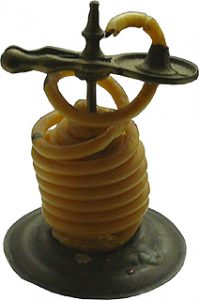
Ostraca
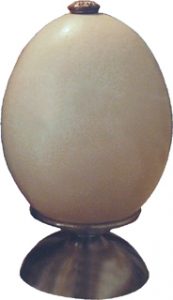
Beltane
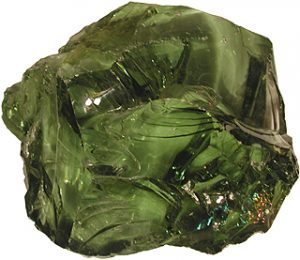 Litha
Litha
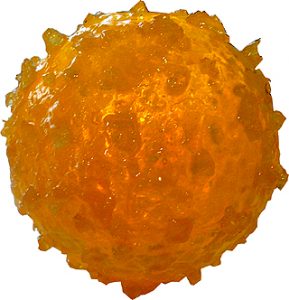
Luchnassad
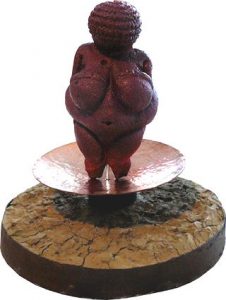
Mabon
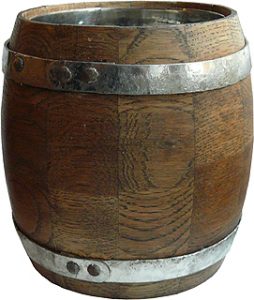
Samhain
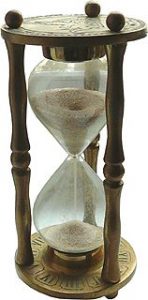
Yule
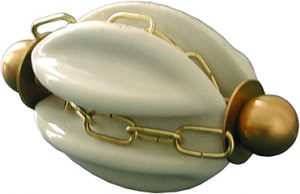
As Yule is not yet come, I place the hour-glass at the center of the circle and for a while am content. From experience I know that making a haggis from scratch, (cleaning a sheep’s stomach and then preparing heart, lungs and liver prior to mixing with oatmeal and stuffing) takes six hours. Nevertheless I would never have thought that a few conceptual considerations concerning an invitation to dinner would occupy me for five weeks – and that was with a vast amount preparatory work already done! Moreover what I do not know is that I am far from finished and more work awaits me in the new year.

After weeks of being distracted from Parmenides, further distraction comes in the form of the audio guide tour of Dürnstein. Conceived of for the Wachau Town Tours page in Week 30, I decide to that the tour should be ready for uploading in January and despite some hiccups manage to achieve this. Whilst working on the Dürnstein tour, I realise that there probably won’t be enough material to make an audio guide of Melk. This is because I am not planning on covering the town’s Benedictine monastery (which has audio guides of its own). Further, I cannot include the town’s museum as it is only open by appointment and is thus unsuitable for tourists. Although I do not have to have four tours, a fourth springs to mind. This is prompted by Hieronymous Übelbacher, the abbot or provost of Dürnstein Abbey, who during the eighteenth century gave the town its now characteristic, UNESCO acknowledged appearance. For Übelbacher, „Wine is everything“ and „Wine is over and above everything“. As these statements beg explanation, I decide that the fourth tour will be dedicated to suppling the missing answers. Entitled „In vino veritas“ it, my plan is for it to be ready by the spring.
2023, Week 52
Provisionally finishing the Dürnstein audio guide tour (it must be tried out in situ and then re-checked before uploading), I start work on the in vino veritas tour and see that the plan I am hatching will work. Nevertheless doubts niggle in the back of my mind concerning my ritual corner dedicated to the cycle of the seasons. Despite the alignments on the Kreuzberg, I still feel that something is missing. As the object representing Yule stands on a plinth that is hollow, I decide that it is in this hollow that something should be kept that underwrites and acts as a form of bond and pledge. To this effect, I begin making a form of seal that draws on the themes covered over the last weeks. Far from being an impression stamped in sealing wax, my seal is hollow and for the space inside, I devise a geometrical theorem which I then drawn on thick card. This is a means of constructing a 13,14,15 triangle from out of a 14,14,14 triangle.
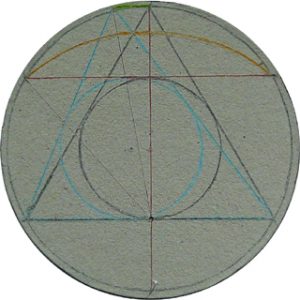
Taking the radius of the circle drawn, six divisions are marked out around the circumference. Taking three non-adjacent divisions as corners, an equilateral triangle is drawn. Then the circle and triangle are divided in half. With the middle of the lower side of the triangle as center, an arc is drawn that links the two divisions on the circumference that are either side of the top of the equilateral triangle. From one of the two lower corners of the equilateral triangle, a line is drawn through the point where the arc crosses the side of the equilateral triangle on the other side of the vertical line that divides the equilateral triangle and the circle. Then this line is extended beyond the circumference of the circle. Again using the middle of the lower side of the equilateral triangle as center, an arc is swung from the top of the equilateral triangle out towards the extended line. The point where this new arc and the extended line intersect is the shifted away corner of the 13,14,15 triangle. Where the 13,14,15 triangle marks out the solar alignments for sunrise on 25th January and sunset on the 7th February, the proportions of the cross of the Kreuzberg are given by a straight line drawn between the two points that define the first arc with this same straight line indicating the radius of a circle drawn within the equilateral triangle.
Constructing a second, inverted cross enables the divisions required for a solar calendar to be easily arrived at.
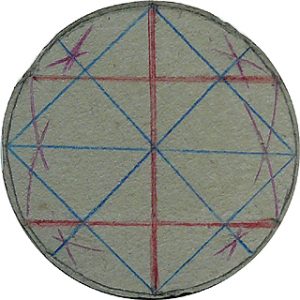
The equilateral triangle represents the super-ordered state of the universe prior to the Big Bang, whilst the 13,14,15 triangle stands for the tiny flaw which initiated it. The shift away from equilateral triangle to 13,14,15 triangle is equatable with the Fall of the Book of Genesis and with the The Way of Seeming of Parmenides. Yet from the construction, the cross of the crucifixion can also be constructed. For me at least, salvation and a means of returning back to the unity of Parmenides‘ One are thus at hand, all united in a single theorem.
On the obverse of the seal, there is an image of an exploding universe, veiled by a covering of amber-like resin.
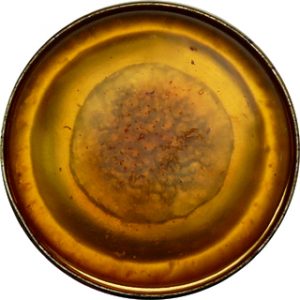
On the reverse, there is a sample of earth from the Kreuzberg.
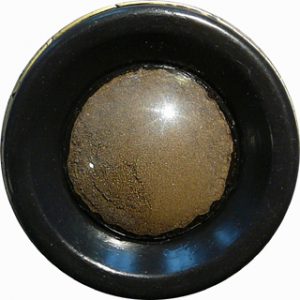
On the inside of the lid, I incorporate the double-headed eagle that is the sparkling wine manufacturer’s emblem. Drawing a triangle around the eagle I then write: „Parmenides“, „Physics“, „Chaos Theory“, along the sides and around about the expanded motto: „out of itself, away from itself, back unto itself“.
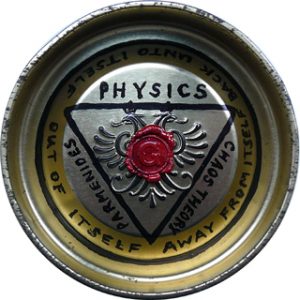
Adding two crowns to the eagle makes it the imperial Habsburg eagle that the towns of Krems and Stein have as coats of arms. However instead of inscribing an „S“ for Stein on the breast, following the example set by Freemasonary, I mark it with a „G“ for geometry, in sealing wax. This done, I realise that I have come closer than ever before to a succinct, symbolically encoded formulation of what it is that I believe in. Going up to the Kreuzberg, I use the amber covering of my seal as a filter and take a photograph of Christ on the cross. By catching a transitory moment in time, the idea is to renew my commitment to what, via the Reloading Humanism website, I have resolved to do and what I am slowly (oh so slowly) setting in motion.
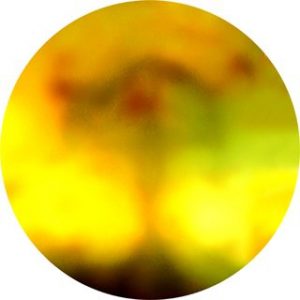
Returning home, I glue the amber covering over the lid and incorporate a print of the image I have taken into the seal. Placing the seal under the hollow plinth on which the object representing Yule stands, I stand back I utter the exclaimation of Week 23:
Soi-e-a-o-u! Soi-e-a-o-u!
